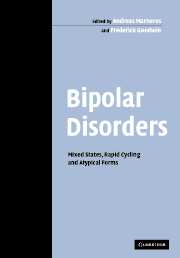Book contents
- Frontmatter
- Contents
- List of contributors
- Preface
- 1 Bipolar disorders beyond major depression and euphoric mania
- 2 Emerging concepts of mixed states: a longitudinal perspective
- 3 Rapid-cycling bipolar disorder
- 4 Bipolar I and bipolar II: a dichotomy?
- 5 Recurrent brief depression as an indicator of severe mood disorders
- 6 Atypical depression and its relation to bipolar spectrum
- 7 Agitated depression: spontaneous and induced
- 8 Schizoaffective mixed states
- 9 Acute and transient psychotic disorder: an atypical bipolar disorder?
- 10 Bipolar disorder in children and adolescents
- 11 Atypical features of bipolarity in old age
- 12 Comorbidity in mixed states and rapid-cycling forms of bipolar disorders
- 13 Challenges in the genetics of bipolar disorder
- 14 Biological aspects of rapid-cycling and mixed states
- 15 The treatment of bipolar mixed states
- 16 The use of atypical antipsychotic agents in the treatment of diagnostic subgroups of bipolar disorder: mixed and pure states, psychotic and non-psychotic
- 17 Investigational strategies: treatment of rapid cycling, mixed episodes, and atypical bipolar mood disorder
- Index
- References
9 - Acute and transient psychotic disorder: an atypical bipolar disorder?
Published online by Cambridge University Press: 10 August 2009
- Frontmatter
- Contents
- List of contributors
- Preface
- 1 Bipolar disorders beyond major depression and euphoric mania
- 2 Emerging concepts of mixed states: a longitudinal perspective
- 3 Rapid-cycling bipolar disorder
- 4 Bipolar I and bipolar II: a dichotomy?
- 5 Recurrent brief depression as an indicator of severe mood disorders
- 6 Atypical depression and its relation to bipolar spectrum
- 7 Agitated depression: spontaneous and induced
- 8 Schizoaffective mixed states
- 9 Acute and transient psychotic disorder: an atypical bipolar disorder?
- 10 Bipolar disorder in children and adolescents
- 11 Atypical features of bipolarity in old age
- 12 Comorbidity in mixed states and rapid-cycling forms of bipolar disorders
- 13 Challenges in the genetics of bipolar disorder
- 14 Biological aspects of rapid-cycling and mixed states
- 15 The treatment of bipolar mixed states
- 16 The use of atypical antipsychotic agents in the treatment of diagnostic subgroups of bipolar disorder: mixed and pure states, psychotic and non-psychotic
- 17 Investigational strategies: treatment of rapid cycling, mixed episodes, and atypical bipolar mood disorder
- Index
- References
Summary
Introduction
Karl Kleist, the main creator of the concept of “cycloid psychoses,” wrote in 1928 that many of the cases allocated by Kraepelin into the group of “mixed states” would better be described as “cycloid psychoses.” In Kleist's opinion, cycloid psychoses are bipolar disorders, but do not belong to the category of manic-depressive insanity (Kleist, 1928, 1953). Cycloid psychoses are the essential component of what the World Health Organization (WHO, 1992) defined as “acute and transient psychotic disorder (ATPD)” (ICD-10 F23). We investigated the ATPD by carrying out the Halle Study on Brief and Acute Psychotic Disorder (HASBAP), which is a longitudinal comparative study (Marneros et al., 2000, 2002; Pillmann et al., 2001; 2002a, b; Marneros and Pillmann, 2004). The HASBAP compares patients with acute and transient psychotic disorders with patients diagnosed as having schizophrenia or bipolar schizoaffective disorder, as well as with a mentally healthy control group. In a further step, we now combine the findings of HASBAP with the findings of the Halle Bipolarity Longitudinal Study (HABILOS), already presented in Chapter 1. In this chapter, we longitudinally compare patients diagnosed as having ATPD from the HASBAP with patients diagnosed as having affective or schizoaffective mixed states belonging to the HABILOS group.
Definitions of acute and transient psychotic disorders
As ATPD (ICD-10 F23), the WHO defines psychotic states having an acute or abrupt onset, usually a good prognosis, and typical symptoms. They may or may not be associated with acute stress (Table 9.1).
Keywords
- Type
- Chapter
- Information
- Bipolar DisordersMixed States, Rapid Cycling and Atypical Forms, pp. 207 - 236Publisher: Cambridge University PressPrint publication year: 2005
References
- 2
- Cited by

